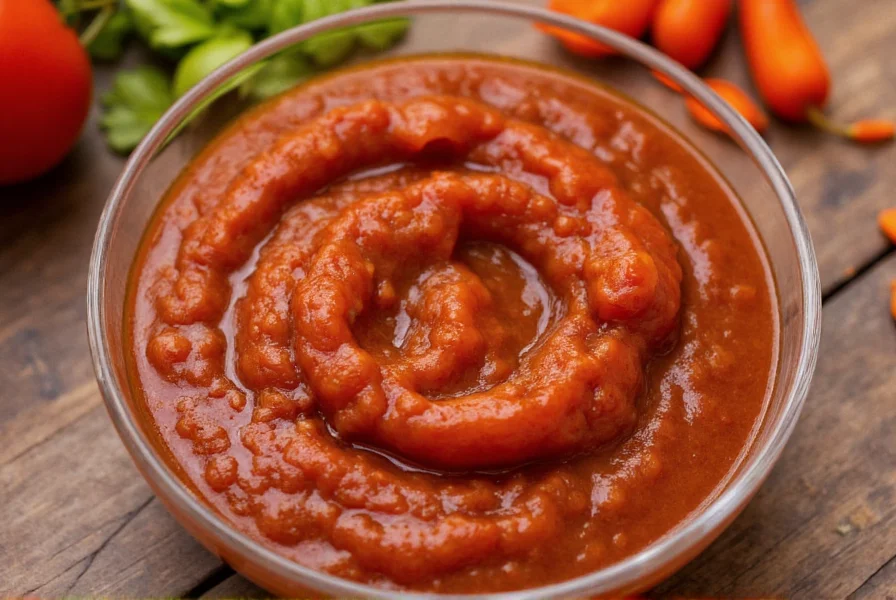Understanding chipotle pepper sauce begins with recognizing its dual-component nature. The chipotles themselves are jalapeños that have been smoke-dried until they develop their characteristic deep red color and intense smokiness. These are then rehydrated and simmered in adobo sauce — a blend typically featuring tomatoes, vinegar, garlic, onion, and warming spices like cumin and oregano. This process creates a complex flavor profile that’s simultaneously smoky, spicy, tangy, and subtly sweet.
Chipotle Pepper Sauce vs. Adobo Sauce: Clearing the Confusion
Many home cooks mistakenly use “chipotle sauce” and “adobo sauce” interchangeably, but they’re distinct components of the same product. When you open a can labeled “chipotle peppers in adobo sauce,” you’re getting two elements:
| Component | Description | Flavor Profile |
|---|---|---|
| Chipotle Peppers | Smoke-dried jalapeños | Deep smokiness with moderate heat (2,500–8,000 SHU) |
| Adobo Sauce | Tomato-vinegar base with garlic and spices | Tangy, slightly sweet, savory with mild spice |
| Chipotle Pepper Sauce | Blended combination of both components | Complex balance of smoke, heat, tang, and sweetness |
True chipotle pepper sauce requires blending both elements together. Simply using adobo sauce alone misses the essential smoky depth from the peppers, while using only the peppers lacks the balanced flavor complexity.
Practical Culinary Applications
Mastering chipotle pepper sauce usage transforms ordinary dishes into restaurant-quality creations. Consider these professional chef-recommended applications:
- Marinades: Combine 2 tablespoons chipotle sauce with 1/4 cup olive oil, 1 tablespoon lime juice, and 1 teaspoon honey for chicken or pork
- Mayo Enhancer: Mix 1 tablespoon into 1/2 cup mayonnaise for smoky sandwiches or dipping sauce
- Soup Depth: Stir 1-2 teaspoons into black bean soup during final simmering
- Brine Booster: Add 1 tablespoon to buttermilk brine for fried chicken
- Vegetable Glaze: Whisk with maple syrup for roasted sweet potatoes

Storage and Shelf Life Guidelines
Proper storage maintains flavor integrity and prevents spoilage. Follow these evidence-based recommendations:
- Unopened cans: Store in cool, dark pantry for 18-24 months
- Opened containers: Transfer to airtight glass container, cover with olive oil layer, refrigerate for 3-4 weeks
- Freezing option: Portion into ice cube trays, freeze solid, then transfer to freezer bags for 6 months
- Signs of spoilage: Mold growth, sour smell, or significant darkening
Homemade vs. Store-Bought Analysis
While canned chipotle peppers in adobo offer convenience, homemade versions provide customization. Here’s how they compare for different cooking scenarios:
- Weeknight cooking: Store-bought provides consistent flavor with zero preparation time
- Special occasions: Homemade allows adjustment of smoke level and spice intensity
- Flavor control: Commercial versions often contain preservatives affecting final dish flavor
- Cost comparison: Homemade costs approximately 30% less per ounce when making in batches

Flavor Pairing Science
Understanding flavor chemistry helps maximize chipotle sauce’s potential. The smoky capsaicin compounds interact best with:
- Dairy products: Casein proteins neutralize capsaicin heat while enhancing smoky notes
- Sweet elements: Sugar molecules balance acidity and moderate perceived heat
- Fatty ingredients: Oils carry and distribute flavor compounds more effectively
- Citrus components: Acids brighten heavy, smoky flavors without diminishing complexity
For optimal results, always add chipotle pepper sauce during the final 5-10 minutes of cooking. Prolonged heat exposure diminishes the delicate smoke compounds while intensifying bitterness from the peppers’ seeds.
Avoiding Common Usage Mistakes
Even experienced cooks make these frequent errors when working with chipotle pepper sauce:
- Over-blending seeds: The seeds contain concentrated capsaicin – remove them before blending for controlled heat
- Adding too early: Introduce during final cooking stages to preserve complex flavor notes
- Ignoring acid balance: Counteract with lime juice when sauce dominates a dish
- Improper measurement: Start with 1 teaspoon per serving, then adjust – heat builds gradually
Frequently Asked Questions
What's the difference between chipotle sauce and adobo sauce?
Chipotle sauce refers to the blended combination of smoked jalapeño peppers and adobo sauce. Adobo sauce alone is the tomato-vinegar base without peppers. Authentic chipotle pepper sauce always contains both components blended together, creating the characteristic smoky-spicy flavor.
How can I reduce the heat level of chipotle pepper sauce?
Remove seeds and white membranes from peppers before blending, as these contain most capsaicin. Alternatively, balance heat by adding dairy (sour cream, yogurt), sweet elements (honey, maple syrup), or acid (lime juice). Start with small amounts and adjust gradually to maintain flavor complexity while reducing perceived heat.
Can I make chipotle pepper sauce from chipotle powder?
Yes, but the flavor profile differs significantly. For substitution, mix 1 tablespoon chipotle powder with 2 tablespoons tomato paste, 1 tablespoon vinegar, 1 minced garlic clove, 1/4 teaspoon cumin, and 2-3 tablespoons water. This creates a reasonable approximation but lacks the authentic smoked pepper depth and texture of true chipotle peppers in adobo sauce.
What are the best substitutes for chipotle pepper sauce?
For similar smoky heat, try smoked paprika mixed with hot sauce (1 teaspoon smoked paprika + 1/2 teaspoon cayenne in 2 tablespoons tomato sauce). Chipotle hot sauce works in some applications but typically contains vinegar and lacks the adobo complexity. Ancho chili paste provides milder smoke without the heat intensity.
Why does my chipotle pepper sauce taste bitter?
Bitterness typically comes from over-processing the seeds or prolonged cooking. Always remove seeds before blending, and add the sauce during the final 5-10 minutes of cooking. If bitterness occurs, balance with 1/2 teaspoon honey or maple syrup and a squeeze of fresh lime juice to restore flavor harmony without masking the desirable smokiness.











 浙公网安备
33010002000092号
浙公网安备
33010002000092号 浙B2-20120091-4
浙B2-20120091-4